MENU
The Electronic Scholarly Publishing Project: Providing access to classic scientific papers and other scholarly materials, since 1993. More About: ESP | OUR CONTENT | THIS WEBSITE | WHAT'S NEW | WHAT'S HOT
Comparative Timelines
The ESP Timeline (one of the site's most popular features) has been completely updated to allow the user to select (using the timeline controls above each column) different topics for the left and right sides of the display.
Select:
New Left Column
New Left Column
Dates
Decade
New Right Column
New Right Column
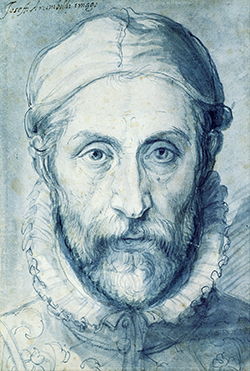 Painting by Giuseppe Arcimboldo: Self Portrait
Painting by Giuseppe Arcimboldo: Self Portrait
Giovanni Padovani publishes a detailed treatise on the construction of sundials, Opus de compositione et usu multiformium horologiorum solarium, in Venice.
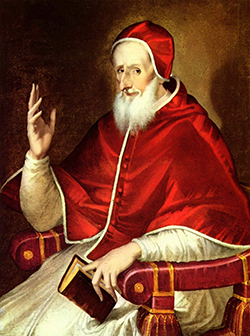 Pope Pius V issues Regnans in Excelsis, a papal bull excommunicating all who obeyed Elizabeth I and calling on all Roman Catholics to rebel against her.
Pope Pius V issues Regnans in Excelsis, a papal bull excommunicating all who obeyed Elizabeth I and calling on all Roman Catholics to rebel against her.
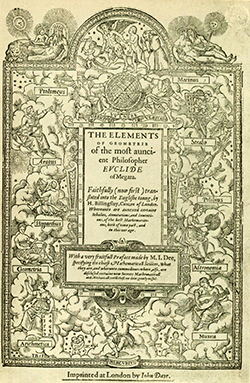 London haberdasher Henry Billingsley makes the first translation of Euclid's Elements into English (from the Greek).
London haberdasher Henry Billingsley makes the first translation of Euclid's Elements into English (from the Greek).
1570
(no entry for this year)
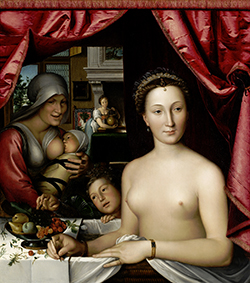 Painting by François Clouet: A Lady in Her Bath The picture is in the National Gallery of Art, Washington DC. It is one of only three paintings signed by Clouet. The bather is unknown. It is possible that she is Diane de Poitiers, mistress of King Henry II of France. Scholar Roger Trinquet suggested in 1966 that the lady is Mary Queen of Scots. The lady's face resembles other portraits of Mary, especially a drawing by Clouet depicting Mary in mourning. Trinquet believes the painting was intended as a satire for a Huguenot patron. The painting set a fashion for portraits of bathers.
Painting by François Clouet: A Lady in Her Bath The picture is in the National Gallery of Art, Washington DC. It is one of only three paintings signed by Clouet. The bather is unknown. It is possible that she is Diane de Poitiers, mistress of King Henry II of France. Scholar Roger Trinquet suggested in 1966 that the lady is Mary Queen of Scots. The lady's face resembles other portraits of Mary, especially a drawing by Clouet depicting Mary in mourning. Trinquet believes the painting was intended as a satire for a Huguenot patron. The painting set a fashion for portraits of bathers.
European doctors start publishing works on healthy properties of the tobacco plant, claiming it can cure a myriad of diseases, from toothache to lockjaw and cancer.
1571
(no entry for this year)
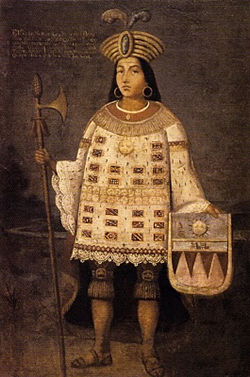 The last Inca leader Tupak Amaru apprehended by Spanish conquistadores at Vilcabamba, Peru, and executed in Cuzco.
The last Inca leader Tupak Amaru apprehended by Spanish conquistadores at Vilcabamba, Peru, and executed in Cuzco.
 A supernova, now designated as SN 1572, is first observed in the constellation Cassiopeia by Cornelius Gemma. Tycho Brahe, who notes it two days later, will use it to challenge the prevailing view that stars do not change.
A supernova, now designated as SN 1572, is first observed in the constellation Cassiopeia by Cornelius Gemma. Tycho Brahe, who notes it two days later, will use it to challenge the prevailing view that stars do not change.
 Girolamo Mercuriale of Forl (Italy) writes the work De morbis cutaneis ("On the diseases of the skin"), the first scientific tract on dermatology.
Girolamo Mercuriale of Forl (Italy) writes the work De morbis cutaneis ("On the diseases of the skin"), the first scientific tract on dermatology.
1572
(no entry for this year)
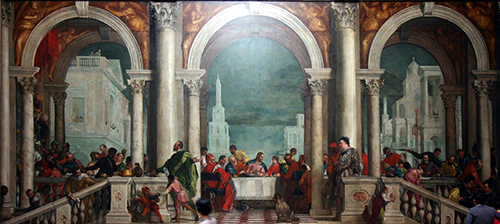 Painting by Paolo Veronese: The Feast in the House of Levi is one of the largest canvases of the 16th century, measuring 555 cm 1,280 cm (18.21 ft 41.99 ft). It is now in the Gallerie dell'Accademia in Venice. It was painted by Veronese for the rear wall of the refectory of the Basilica di Santi Giovanni e Paolo, a Dominican friary, as a Last Supper, to replace an earlier work by Titian destroyed in the fire of 1571. However, the painting led to an investigation by the Roman Catholic Inquisition. Veronese was called to answer for irreverence and indecorum, and the serious offence of heresy was mentioned. He was asked to explain why the painting contained "buffoons, drunken Germans, dwarfs and other such scurrilities" as well as extravagant costumes and settings, in what is indeed a fantasy version of a Venetian patrician feast. Veronese was told that he must change his painting within a three-month period; instead, he simply changed the title to The Feast in the House of Levi, still an episode from the Gospels, but less doctrinally central, and one in which the Gospels specified "sinners" as present. After this, no more was said.
Painting by Paolo Veronese: The Feast in the House of Levi is one of the largest canvases of the 16th century, measuring 555 cm 1,280 cm (18.21 ft 41.99 ft). It is now in the Gallerie dell'Accademia in Venice. It was painted by Veronese for the rear wall of the refectory of the Basilica di Santi Giovanni e Paolo, a Dominican friary, as a Last Supper, to replace an earlier work by Titian destroyed in the fire of 1571. However, the painting led to an investigation by the Roman Catholic Inquisition. Veronese was called to answer for irreverence and indecorum, and the serious offence of heresy was mentioned. He was asked to explain why the painting contained "buffoons, drunken Germans, dwarfs and other such scurrilities" as well as extravagant costumes and settings, in what is indeed a fantasy version of a Venetian patrician feast. Veronese was told that he must change his painting within a three-month period; instead, he simply changed the title to The Feast in the House of Levi, still an episode from the Gospels, but less doctrinally central, and one in which the Gospels specified "sinners" as present. After this, no more was said.
French surgeon Ambroise Paré publishes the first edition of Des Monstres et Prodiges. At this time, surgeons are not regarded as real doctors, and Paré is roundly criticized for discussing larger issues of medicine and philosophy, considered well beyond his purview.
1573
(no entry for this year)
In Rome (Italy), in the river Tiber between the two bridges, the monument base is discovered for a statue of Simon Paeter (or Simon the Sorcerer, the "Magus of Samaria"), with inscription "Simoni Deo Sancto" (translation: "To Simon the Holy God").
1574
(no entry for this year)
(no entry for this year)
1575
(no entry for this year)
English navigator Martin Frobisher sights Greenland.
1576
(no entry for this year)
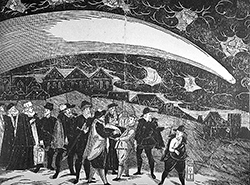 The Great Comet of 1577 (official designation: C/1577 V1) was a comet that passed close to Earth during the year 1577 AD. It was viewed by people all over Europe, including the famous Danish astronomer Tycho Brahe and Turkish astronomer Taqi ad-Din. From his observations of the comet, Brahe was able to discover that comets and similar objects travel above the Earth's atmosphere. The best fit using JPL Horizons suggests that the comet is currently about 320 AU from the Sun (based on 24 of Brahe's observations spanning 74 days from 13 November 1577 to 26 January 1578).
The Great Comet of 1577 (official designation: C/1577 V1) was a comet that passed close to Earth during the year 1577 AD. It was viewed by people all over Europe, including the famous Danish astronomer Tycho Brahe and Turkish astronomer Taqi ad-Din. From his observations of the comet, Brahe was able to discover that comets and similar objects travel above the Earth's atmosphere. The best fit using JPL Horizons suggests that the comet is currently about 320 AU from the Sun (based on 24 of Brahe's observations spanning 74 days from 13 November 1577 to 26 January 1578).
1577
(no entry for this year)
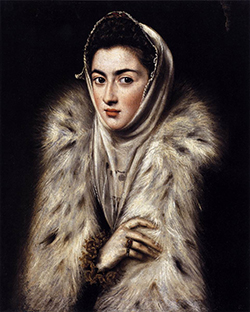 Painting by El Greco: Lady in a Fur Wrap against a dark background a young woman gazes at the viewer, dressed in a fur robe covering the rest of her dress. A fine transparent veil covers her head, and vaguely a neckace can be seen that she is wearing underneath it. The robe falls into darkness behind its fur lining, that may be ermine or lynx. The painting is unsigned but has traditionally been attributed to El Greco since it was in the collection of French king Louis Philippe I and hung at the Louvre.
Painting by El Greco: Lady in a Fur Wrap against a dark background a young woman gazes at the viewer, dressed in a fur robe covering the rest of her dress. A fine transparent veil covers her head, and vaguely a neckace can be seen that she is wearing underneath it. The robe falls into darkness behind its fur lining, that may be ermine or lynx. The painting is unsigned but has traditionally been attributed to El Greco since it was in the collection of French king Louis Philippe I and hung at the Louvre.
English seaman William Bourne publishes a manual, Inventions or Devises, Very Necessary for all Generalles and Captaines, as wel by Sea as by Land, including an early theoretical description of a submarine.
Li Shizhen completes the first draft of the materia medica Bencao Gangmu.
1578
(no entry for this year)
Francis Drake, during his circumnavigation of the world, lands in what is now California, which he claims for Queen Elizabeth I of England as Nova Albion.
 Hieronymus Fabricius discovers the membranous folds that serve as valves in the veins.
Hieronymus Fabricius discovers the membranous folds that serve as valves in the veins.
1579
(no entry for this year)
ESP Quick Facts
ESP Origins
In the early 1990's, Robert Robbins was a faculty member at Johns Hopkins, where he directed the informatics core of GDB — the human gene-mapping database of the international human genome project. To share papers with colleagues around the world, he set up a small paper-sharing section on his personal web page. This small project evolved into The Electronic Scholarly Publishing Project.
ESP Support
In 1995, Robbins became the VP/IT of the Fred Hutchinson Cancer Research Center in Seattle, WA. Soon after arriving in Seattle, Robbins secured funding, through the ELSI component of the US Human Genome Project, to create the original ESP.ORG web site, with the formal goal of providing free, world-wide access to the literature of classical genetics.
ESP Rationale
Although the methods of molecular biology can seem almost magical to the uninitiated, the original techniques of classical genetics are readily appreciated by one and all: cross individuals that differ in some inherited trait, collect all of the progeny, score their attributes, and propose mechanisms to explain the patterns of inheritance observed.
ESP Goal
In reading the early works of classical genetics, one is drawn, almost inexorably, into ever more complex models, until molecular explanations begin to seem both necessary and natural. At that point, the tools for understanding genome research are at hand. Assisting readers reach this point was the original goal of The Electronic Scholarly Publishing Project.
ESP Usage
Usage of the site grew rapidly and has remained high. Faculty began to use the site for their assigned readings. Other on-line publishers, ranging from The New York Times to Nature referenced ESP materials in their own publications. Nobel laureates (e.g., Joshua Lederberg) regularly used the site and even wrote to suggest changes and improvements.
ESP Content
When the site began, no journals were making their early content available in digital format. As a result, ESP was obliged to digitize classic literature before it could be made available. For many important papers — such as Mendel's original paper or the first genetic map — ESP had to produce entirely new typeset versions of the works, if they were to be available in a high-quality format.
ESP Help
Early support from the DOE component of the Human Genome Project was critically important for getting the ESP project on a firm foundation. Since that funding ended (nearly 20 years ago), the project has been operated as a purely volunteer effort. Anyone wishing to assist in these efforts should send an email to Robbins.
ESP Plans
With the development of methods for adding typeset side notes to PDF files, the ESP project now plans to add annotated versions of some classical papers to its holdings. We also plan to add new reference and pedagogical material. We have already started providing regularly updated, comprehensive bibliographies to the ESP.ORG site.
ESP Picks from Around the Web (updated 06 MAR 2017 )
Old Science

Weird Science

Treating Disease with Fecal Transplantation
Fossils of miniature humans (hobbits) discovered in Indonesia

Dinosaur tail, complete with feathers, found preserved in amber.
Astronomy

Mysterious fast radio burst (FRB) detected in the distant universe.